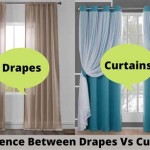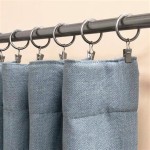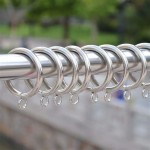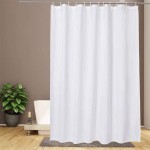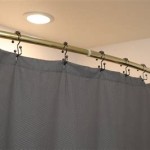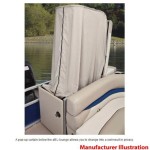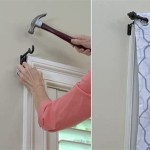How To Secure Outdoor Curtains Against the Elements
Outdoor curtains provide a valuable aesthetic and functional addition to patios, decks, and other outdoor living spaces. They offer privacy, shade from the sun, and protection from light rain and wind. However, the lightweight nature of many curtain fabrics makes them susceptible to being blown around by even a gentle breeze. Successfully holding down outdoor curtains is essential for maintaining their intended purpose and preventing damage to the curtains themselves, the curtain rods, and surrounding structures.
Several factors contribute to the challenge of keeping outdoor curtains in place. The fabric's weight, the severity of the weather in a given location, and the design and installation of the curtain rod all play a role. Choosing the right method for securing curtains requires careful consideration of these factors to ensure long-lasting and effective results.
Choosing Weighted Fabrics for Natural Stability
One of the most effective strategies for minimizing curtain movement is to select heavier fabrics during the initial purchase. Materials like canvas, outdoor-specific polyester blends, and duck cloth offer inherent weight that helps resist wind. These fabrics are designed to withstand outdoor conditions, resisting fading, mildew, and water damage, further contributing to their longevity and value.
When choosing a heavier fabric, consider the overall aesthetic and the structural integrity of the curtain rod. The added weight may require a sturdier rod and mounting hardware to prevent sagging or detachment. It is essential to check the weight capacity of the rod and choose a fabric that falls within that limit. If the existing rod is not strong enough, upgrading it before hanging the curtains is highly recommended.
Another option is to add weight to lighter fabrics. This can be achieved through various methods, such as sewing weighted tape into the hem of the curtain. Weighted tape is available in different weights and widths, allowing for customization based on the fabric and the anticipated wind conditions. Evenly distributing the weight along the hem prevents the curtain from billowing unevenly.
Alternatively, consider adding chain weights along the bottom hem. Chain weights offer a more substantial and visible solution. They can be easily attached using fabric glue or sewn into place. The weight and the spacing of the chains can be adjusted to provide the desired level of wind resistance. However, ensure the chains are rust-proof to prevent staining of the fabric and surrounding surfaces.
Beyond the hem, adding small weights intermittently throughout the curtain can further reduce movement. Small, decorative weights can be clipped or sewn onto the fabric at regular intervals. These can be found in various styles and materials, allowing for a discreet and aesthetically pleasing approach to adding weight. Ensure the weights are securely attached to prevent them from falling off and posing a hazard.
Utilizing Tie-Backs, Straps, and Anchors for Secure Positioning
Tie-backs, straps, and anchors offer a more direct approach to securing curtains in a specific position. These methods physically restrain the curtains, preventing them from blowing freely in the wind. The choice of method depends on the desired level of restraint, the aesthetic preferences, and the existing architectural features of the outdoor space.
Tie-backs are fabric or rope loops that attach to the curtain and then to a fixed point on a wall, post, or other support structure. They typically loop around the curtain and are secured with a knot, button, or hook-and-loop fastener. Tie-backs are a versatile option, allowing for the curtains to be fully open, partially open, or completely closed, depending on the desired level of privacy and shade.
When selecting tie-backs, consider the material and style to ensure they complement the curtains and the overall aesthetic of the outdoor space. Durable outdoor fabrics like canvas or rope are recommended to withstand the elements. The color and pattern of the tie-backs can be chosen to either blend in with the curtains or provide a contrasting accent. Installation typically involves attaching a small hook or loop to the wall or post at the desired height.
Straps offer a similar function to tie-backs but typically feature a more streamlined design. They often consist of a strip of fabric or leather with a buckle or snap closure. Straps can be used to wrap around the curtain and secure it to a fixed point, or they can be used to connect the curtain to itself, creating a gathered or draped effect. The adjustability of straps allows for precise control over the curtain's positioning.
Anchors provide a more permanent solution for securing curtains. These typically involve attaching a small weight or clip to the bottom of the curtain and then securing it to the ground or a low-level structure. Anchors can be particularly effective in preventing the bottom of the curtain from lifting in the wind. However, they may limit the ability to fully open or adjust the curtains.
Ground anchors come in various forms, including stakes, hooks, and weights. Stakes can be driven into the ground and attached to the curtain with a clip or loop. Hooks can be attached to a low-level structure, such as a deck railing, and the curtain can be hung on the hook. Weights can be placed on the ground and attached to the curtain with a clip or loop. Ensure that ground anchors are made of rust-proof materials to prevent staining and corrosion.
Upgrading Curtain Rods and Hardware for Enhanced Stability
The curtain rod and hardware play a crucial role in maintaining the stability of outdoor curtains. A flimsy or poorly installed rod can easily bend or break under the strain of wind and the weight of the curtains. Upgrading to a sturdier rod and using appropriate hardware can significantly improve the overall performance and longevity of the curtains.
Choose a curtain rod made of durable materials such as galvanized steel, stainless steel, or powder-coated aluminum. These materials are resistant to rust and corrosion, ensuring they can withstand outdoor conditions. The diameter of the rod should be sufficient to support the weight of the curtains and the expected wind load. Consider using a rod with a larger diameter for heavier fabrics or in areas prone to strong winds.
The mounting hardware should also be chosen with care. Use heavy-duty brackets that are specifically designed for outdoor use. Ensure the brackets are securely attached to the wall, post, or other support structure. Consider using longer screws or bolts to provide a more secure hold, especially in areas with high winds. The spacing between the brackets should be appropriate for the length of the rod and the weight of the curtains to prevent sagging.
To further enhance stability, consider using a rod pocket curtain. Rod pocket curtains have a sewn-in channel at the top that slides directly onto the rod. This creates a more secure connection between the curtain and the rod, reducing the likelihood of the curtain slipping or being blown off. Alternatively, use curtain rings with clips that are securely attached to both the curtain and the rod. Ensure the clips are strong enough to hold the weight of the curtain and resist the force of the wind.
In areas with particularly strong winds, consider using a tension rod in conjunction with other methods. A tension rod is installed by compressing it between two surfaces, providing additional support to the curtain rod. This can help to prevent the rod from bending or breaking under extreme wind conditions. However, tension rods are best suited for shorter spans and may not be appropriate for all outdoor spaces.
Finally, regularly inspect the curtain rod and hardware for signs of wear or damage. Tighten any loose screws or bolts, and replace any damaged parts promptly. Proper maintenance is essential for ensuring the long-term stability and performance of outdoor curtains.

How To Keep Outdoor Curtains From Blowing In Wind A Nest With Yard

12 Ways To Keep Outdoor Curtains From Blowing In The Wind Homelyville

Keep Your Outdoor Curtains From Blowing In The Wind You Can Run A Cable Or Clothesline Thru Bottom Hem And Attaching To Dog Tie Out Stakes Into Ground Attach

How To Hang Outdoor Drapes Diy Curtain Rods Polka Dot Chair

How To Keep Outdoor Curtains From Blowing In The Wind Proline Range Hoods

Diy Floating Outdoor Curtain Rod Creating A Privacy Curtains For Deck

Diy Outdoor Curtains And Screened Porch For Under 50

How To Secure Outdoor Curtains Against The Wind Youtube
Make Your Own Outdoor Pergola Curtains A Beautiful Mess

Diy Floating Outdoor Curtain Rod Creating A Privacy Curtains For Deck


